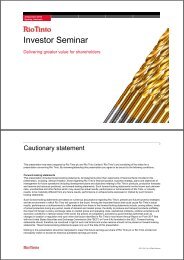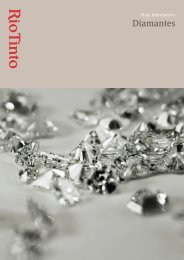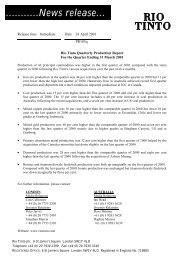Luzenac 20-pages - Rio Tinto
Luzenac 20-pages - Rio Tinto
Luzenac 20-pages - Rio Tinto
Create successful ePaper yourself
Turn your PDF publications into a flip-book with our unique Google optimized e-Paper software.
wastewater treatment<br />
New solutions for biological<br />
wastewater treatment plants<br />
One of the principal problems facing<br />
biological wastewater treatment plant<br />
operators is how to deal with the huge<br />
volumes of wet sludge left at the end of<br />
the settling process.<br />
At the Pollutec Exhibition held in Paris<br />
in December <strong>20</strong>03, <strong>Luzenac</strong> presented a<br />
new application for its Aquatal® range<br />
aimed to optimise the sludge dewatering<br />
process.<br />
Aquatal® is a natural, environmentally<br />
friendly blend of talc and chlorite<br />
with a specific mineral composition<br />
and particle size distribution. It is a<br />
structuring agent, which improves<br />
water/sludge separation efficiency.<br />
Aquatal® speeds up the separation of<br />
the solid and liquid phases during<br />
crop protection<br />
Talc protects growing fruit…<br />
naturally<br />
There is nothing quite like biting into a<br />
sweet, juicy Granny Smith apple on a<br />
hot summer day, or baking them into a<br />
homemade, deep-dish apple pie.<br />
However, in order to get this highly<br />
popular fruit to market, it first has to<br />
survive the rigours of maturing in the<br />
orchard—and dealing with the harsh,<br />
burning UV-rays of the sun. Yes, just like<br />
people, fruit can get sunburn. In fact, if<br />
left unattended, sunburn and heat<br />
stress can damage up to 45% of a<br />
typical crop.<br />
To combat this problem, <strong>Luzenac</strong><br />
has begun development of a new<br />
draining and facilitates water<br />
extraction during pressing. It also<br />
improves flocculation, preventing<br />
seepage, mesh clogging and sticking of<br />
sludge cakes.<br />
A low dosage of Aquatal® before the<br />
dewatering process enables wastewater<br />
treatment plant operators to reduce<br />
volume and mass of wet sludge,<br />
accelerate machine throughput and<br />
optimise sludge preparation.<br />
Aquatal® is already used in over 150<br />
municipal and industrial wastewater<br />
treatment plants in Europe to improve<br />
sludge settleability in the case of<br />
bulking and hydraulic or organic overload.<br />
With the development of this new<br />
application, Aquatal® now provides<br />
wastewater treatment plant operators<br />
with an all-round natural solution.<br />
talc-based crop protectant product,<br />
Invelop® SPF. Initial trials conducted<br />
in <strong>20</strong>03 evaluated sunburn protection<br />
for apples. The data showed that when<br />
Invelop® SPF was sprayed onto Granny<br />
Smith apples it reduced the surface<br />
temperature and lowered the incidence<br />
of sunburn by up to 60%.<br />
Invelop® SPF is a natural solution to a<br />
natural problem, replacing the use of<br />
synthetic chemicals and continuous<br />
cooling water sprays. EPA registration<br />
and approvals for use in organic<br />
farming are expected for Invelop® SPF.<br />
Further trials on grapes, pears, and<br />
plums will be conducted in <strong>20</strong>04.<br />
sustainable construction materials<br />
Talc for sustainable construction materials<br />
One of our major innovations in <strong>20</strong>03 was an<br />
engineered talc product for the wood-plastic<br />
composite market.<br />
Wood-plastic composites are a mixture of<br />
plastic, wood flour, sawdust or other natural<br />
fibres and, in some cases, minerals. These<br />
components are melt blended in extruders<br />
or other processing devices to form a variety<br />
of extruded profiles, thermoformed and<br />
compression moulded parts used to construct<br />
patio decking, window frames, doors, railings,<br />
roofing, patio furniture, fencing, docks and<br />
garden structures.<br />
Wood-plastic composites present a range of<br />
advantages from a sustainable development<br />
point of view:<br />
• They provide an outlet for scrap plastic,<br />
recycled plastics, waste wood and side<br />
products from the wood processing industry;<br />
• They provide a viable alternative to impregnated<br />
wood, which may contain toxic<br />
substances, as well as valued hardwoods;<br />
talc for the world 15<br />
• They are easy to recycle and can be ultimately<br />
burnt for the production of heat;<br />
• They are highly durable and have low-maintenance<br />
requirements;<br />
• They eliminate paint, thus reducing VOC<br />
emissions;<br />
• They have extended functional service life<br />
and enhanced weatherability.<br />
For the time being, these composites are<br />
primarily used for non-structural applications.<br />
However, research performed by <strong>Luzenac</strong><br />
America and Washington State University<br />
has shown that incorporating talc into woodplastic<br />
composites considerably enhances<br />
their performance in terms of stiffness,<br />
dimensional stability and water resistance,<br />
making talc-reinforced wood-plastic composites<br />
suitable for use in structural applications<br />
such as decking supports, piers and home<br />
construction.<br />
Talc-reinforced plastic composites may well<br />
become a major material for the construction<br />
market in years to come.<br />
talc the mineral












![Download pdf file [PDF: 1.26 MB] - Rio Tinto](https://img.yumpu.com/10319684/1/190x253/download-pdf-file-pdf-126-mb-rio-tinto.jpg?quality=85)




